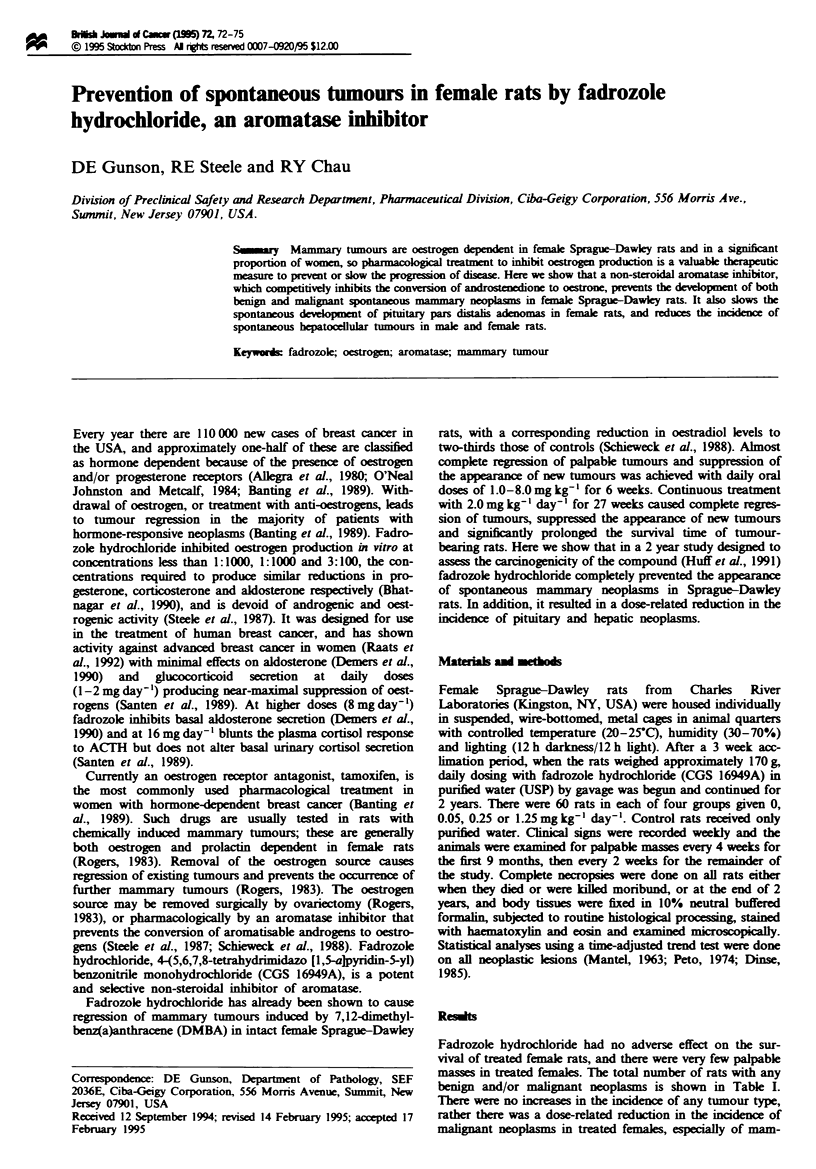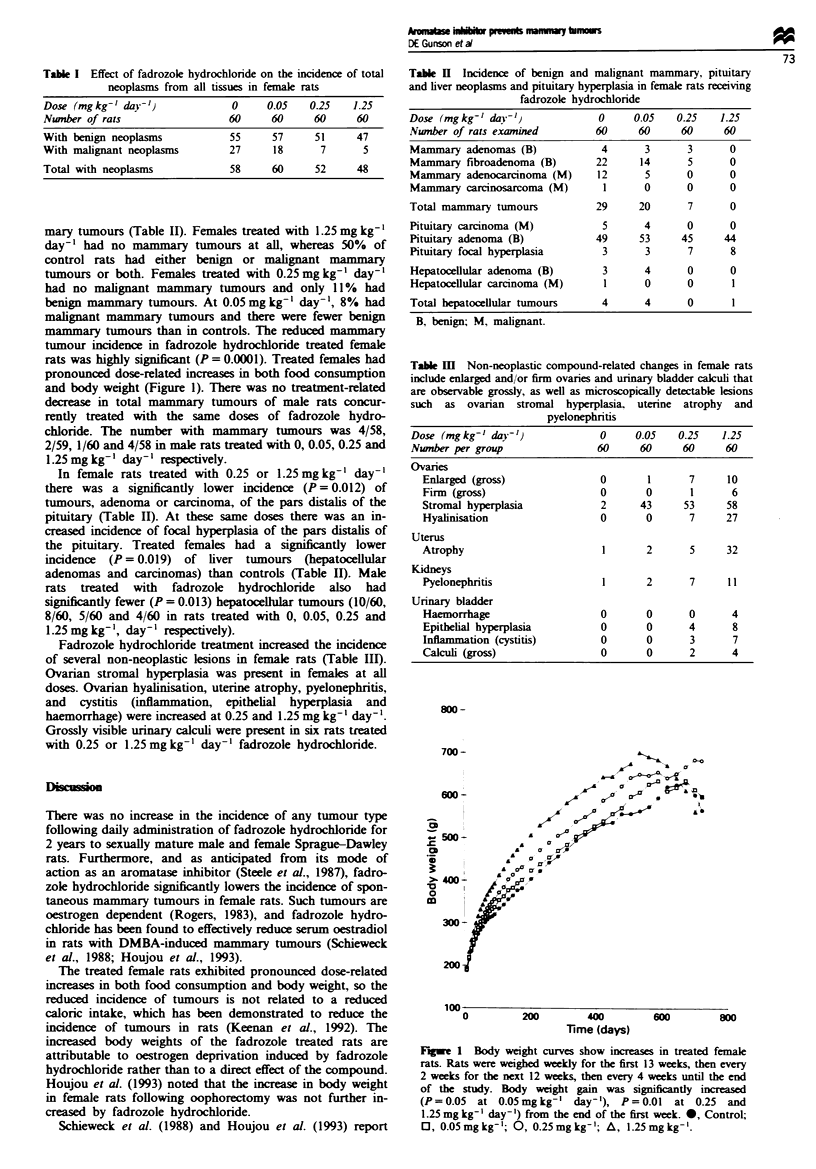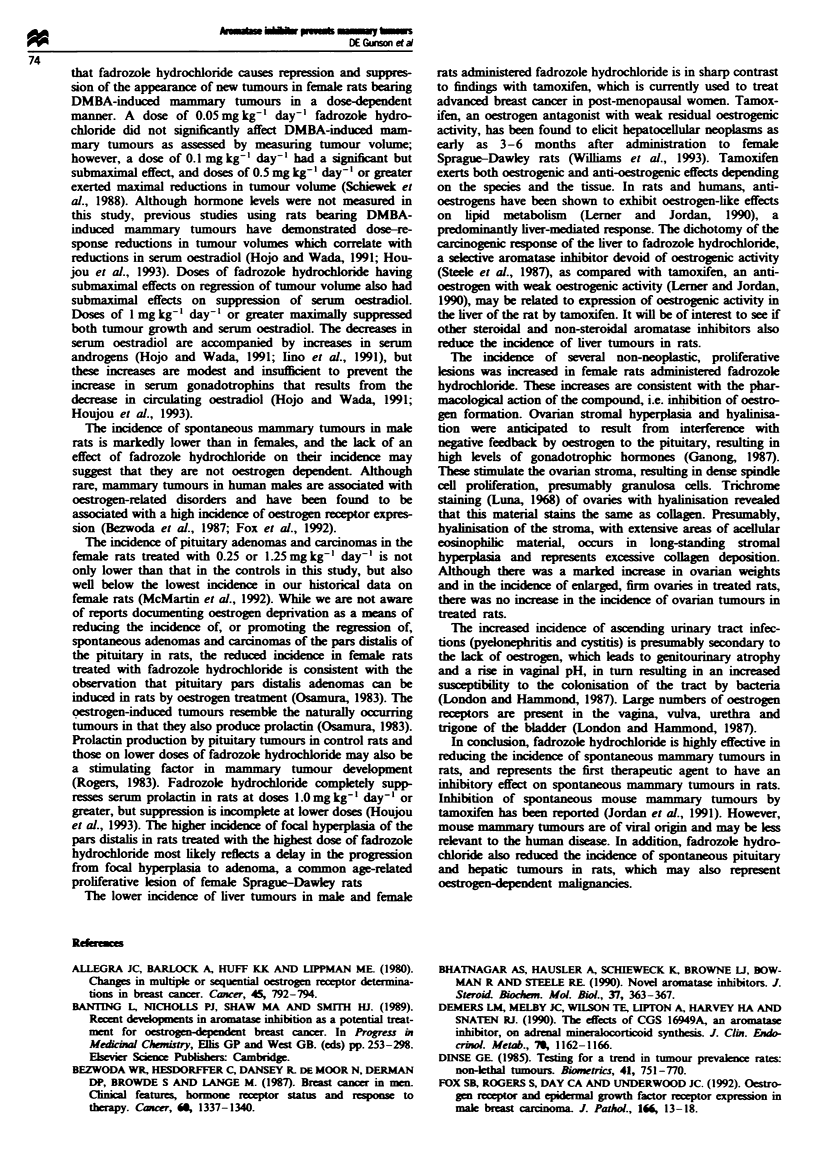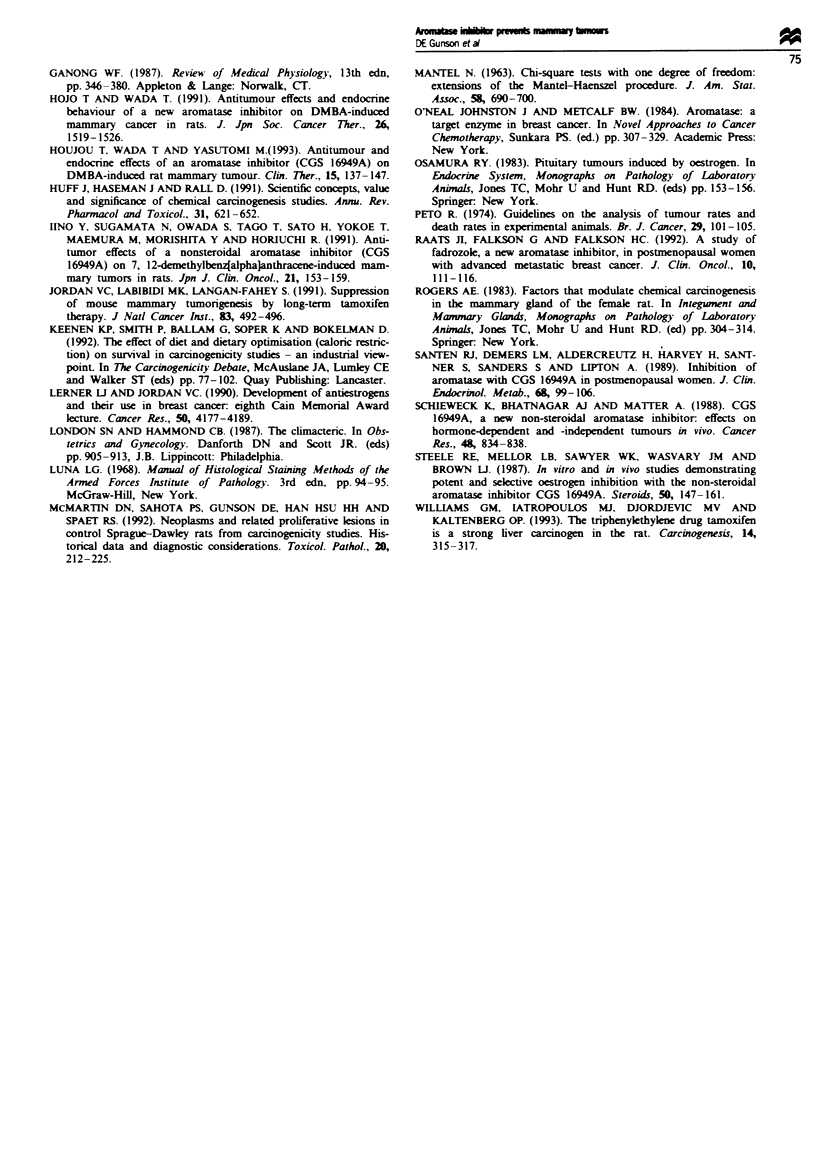Abstract
Mammary tumours are oestrogen dependent in female Sprague-Dawley rats and in a significant proportion of women, so pharmacological treatment to inhibit oestrogen production is a valuable therapeutic measure to prevent or slow the progression of disease. Here we show that a non-steroidal aromatase inhibitor, which competitively inhibits the conversion of androstenedione to oestrone, prevents the development of both benign and malignant spontaneous mammary neoplasms in female Sprague-Dawley ats. It also slows the spontaneous development of pituitary pars distalis adenomas in female rats, and reduces the incidence of spontaneous hepatocellular tumours in male and female rats.
Full text
PDF



Selected References
These references are in PubMed. This may not be the complete list of references from this article.
- Allegra J. C., Barlock A., Huff K. K., Lippman M. E. Changes in multiple or sequential estrogen receptor determinations in breast cancer. Cancer. 1980 Feb 15;45(4):792–794. doi: 10.1002/1097-0142(19800215)45:4<792::aid-cncr2820450430>3.0.co;2-x. [DOI] [PubMed] [Google Scholar]
- Banting L., Nicholls P. J., Shaw M. A., Smith H. J. Recent developments in aromatase inhibition as a potential treatment for oestrogen-dependent breast cancer. Prog Med Chem. 1989;26:253–298. doi: 10.1016/s0079-6468(08)70242-x. [DOI] [PubMed] [Google Scholar]
- Bezwoda W. R., Hesdorffer C., Dansey R., de Moor N., Derman D. P., Browde S., Lange M. Breast cancer in men. Clinical features, hormone receptor status, and response to therapy. Cancer. 1987 Sep 15;60(6):1337–1340. doi: 10.1002/1097-0142(19870915)60:6<1337::aid-cncr2820600629>3.0.co;2-c. [DOI] [PubMed] [Google Scholar]
- Bhatnagar A. S., Häusler A., Schieweck K., Browne L. J., Bowman R., Steele R. E. Novel aromatase inhibitors. J Steroid Biochem Mol Biol. 1990 Nov 20;37(3):363–367. doi: 10.1016/0960-0760(90)90485-4. [DOI] [PubMed] [Google Scholar]
- Demers L. M., Melby J. C., Wilson T. E., Lipton A., Harvey H. A., Santen R. J. The effects of CGS 16949A, an aromatase inhibitor on adrenal mineralocorticoid biosynthesis. J Clin Endocrinol Metab. 1990 Apr;70(4):1162–1166. [PubMed] [Google Scholar]
- Dinse G. E. Testing for a trend in tumor prevalence rates: I. Nonlethal tumors. Biometrics. 1985 Sep;41(3):751–770. [PubMed] [Google Scholar]
- Fox S. B., Rogers S., Day C. A., Underwood J. C. Oestrogen receptor and epidermal growth factor receptor expression in male breast carcinoma. J Pathol. 1992 Jan;166(1):13–18. doi: 10.1002/path.1711660104. [DOI] [PubMed] [Google Scholar]
- Houjou T., Wada T., Yasutomi M. Antitumor and endocrine effects of an aromatase inhibitor (CGS 16949A) on DMBA-induced rat mammary tumor. Clin Ther. 1993 Jan-Feb;15(1):137–147. [PubMed] [Google Scholar]
- Huff J., Haseman J., Rall D. Scientific concepts, value, and significance of chemical carcinogenesis studies. Annu Rev Pharmacol Toxicol. 1991;31:621–652. doi: 10.1146/annurev.pa.31.040191.003201. [DOI] [PubMed] [Google Scholar]
- Iino Y., Sugamata N., Owada S., Tago T., Sato H., Yokoe T., Maemura M., Morishita Y., Horiuchi R. Antitumor effects of a nonsteroidal aromatase inhibitor (CGS 16949A) on 7, 12-dimethylbenz[alpha]anthracene-induced mammary tumors in rats. Jpn J Clin Oncol. 1991 Jun;21(3):153–159. [PubMed] [Google Scholar]
- Jordan V. C., Lababidi M. K., Langan-Fahey S. Suppression of mouse mammary tumorigenesis by long-term tamoxifen therapy. J Natl Cancer Inst. 1991 Apr 3;83(7):492–496. doi: 10.1093/jnci/83.7.492. [DOI] [PubMed] [Google Scholar]
- Lerner L. J., Jordan V. C. Development of antiestrogens and their use in breast cancer: eighth Cain memorial award lecture. Cancer Res. 1990 Jul 15;50(14):4177–4189. [PubMed] [Google Scholar]
- McMartin D. N., Sahota P. S., Gunson D. E., Hsu H. H., Spaet R. H. Neoplasms and related proliferative lesions in control Sprague-Dawley rats from carcinogenicity studies. Historical data and diagnostic considerations. Toxicol Pathol. 1992;20(2):212–225. doi: 10.1177/019262339202000208. [DOI] [PubMed] [Google Scholar]
- Raats J. I., Falkson G., Falkson H. C. A study of fadrozole, a new aromatase inhibitor, in postmenopausal women with advanced metastatic breast cancer. J Clin Oncol. 1992 Jan;10(1):111–116. doi: 10.1200/JCO.1992.10.1.111. [DOI] [PubMed] [Google Scholar]
- Santen R. J., Demers L. M., Adlercreutz H., Harvey H., Santner S., Sanders S., Lipton A. Inhibition of aromatase with CGS 16949A in postmenopausal women. J Clin Endocrinol Metab. 1989 Jan;68(1):99–106. doi: 10.1210/jcem-68-1-99. [DOI] [PubMed] [Google Scholar]
- Schieweck K., Bhatnagar A. S., Matter A. CGS 16949A, a new nonsteroidal aromatase inhibitor: effects on hormone-dependent and -independent tumors in vivo. Cancer Res. 1988 Feb 15;48(4):834–838. [PubMed] [Google Scholar]
- Steele R. E., Mellor L. B., Sawyer W. K., Wasvary J. M., Browne L. J. In vitro and in vivo studies demonstrating potent and selective estrogen inhibition with the nonsteroidal aromatase inhibitor CGS 16949A. Steroids. 1987 Jul-Sep;50(1-3):147–161. doi: 10.1016/0039-128x(83)90068-5. [DOI] [PubMed] [Google Scholar]
- Williams G. M., Iatropoulos M. J., Djordjevic M. V., Kaltenberg O. P. The triphenylethylene drug tamoxifen is a strong liver carcinogen in the rat. Carcinogenesis. 1993 Feb;14(2):315–317. doi: 10.1093/carcin/14.2.315. [DOI] [PubMed] [Google Scholar]


